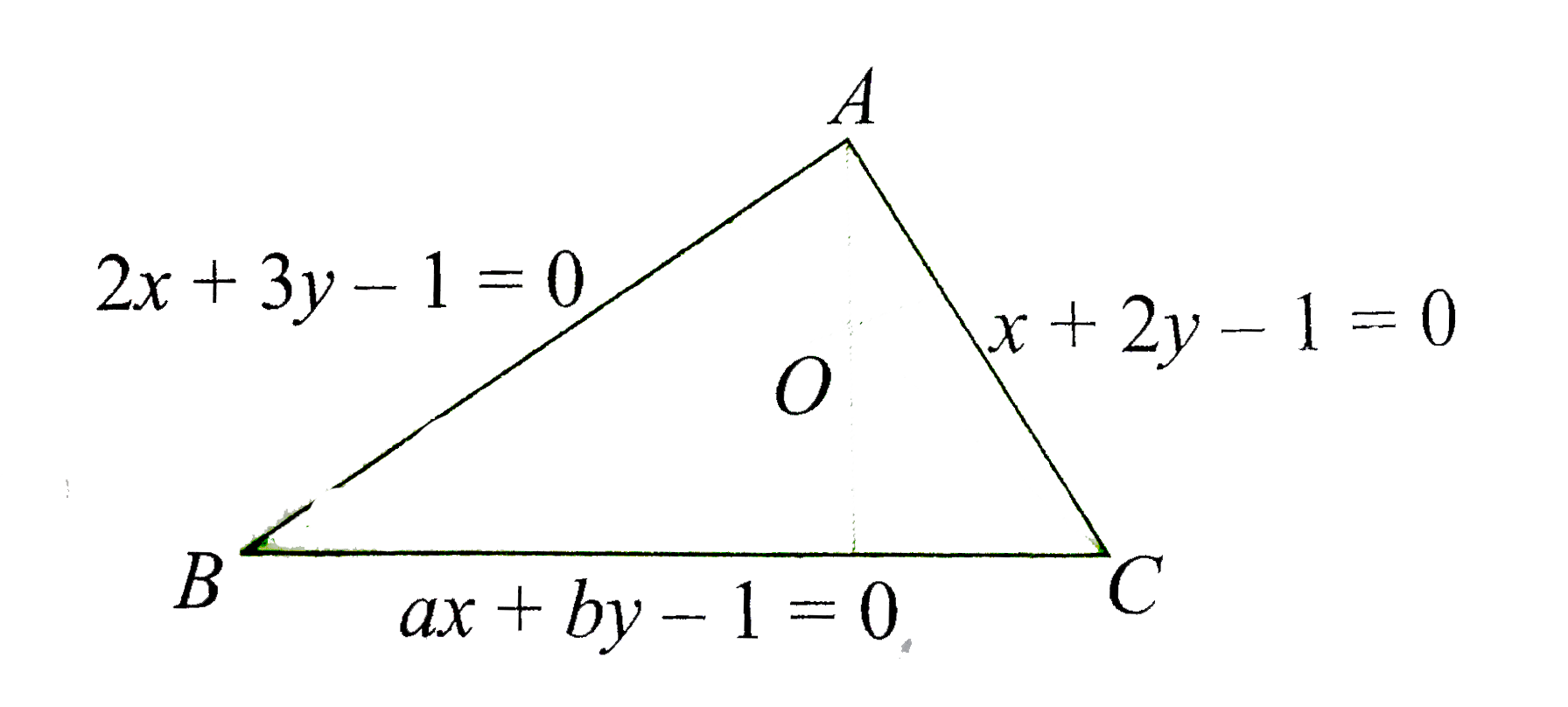If the straight lines 2x+3y−1=0,x+2y−1=0,andax+by−1=0form a triangle with the origin as orthocentre, then (a,b)is given bySolution in Tamil
(6,4)
(-3,3)
(-8,8)
(0,7)
The correct Answer is:C

The equation of AO is 2x+3y−1+λ(x+2y−1)=0, where λ=−1, since the line passes through the origin. So, x+y=0. Since AO is perpendicular to BC, we have (−1)(−ab)=−1
∴a=−b
Similarly,
(2x+3y−1)+μ(ax−ay−1)=0
will be the equation of BO for μ=−1. Now, BO is perpendicular to AC. Hence,
{−(2−a)3+a}(−12)=−1
∴a=−8,b=8
Topper's Solved these Questions
- STRAIGHT LINESBOOK - CENGAGECHAPTER - STRAIGHT LINESEXERCISE - Exercise (Multiple)
30 Videos
- STRAIGHT LINESBOOK - CENGAGECHAPTER - STRAIGHT LINESEXERCISE - Exercise (Comprehension)
27 Videos
- STRAIGHT LINESBOOK - CENGAGECHAPTER - STRAIGHT LINESEXERCISE - Exercise 2.6
5 Videos
- STRAIGHT LINEBOOK - CENGAGECHAPTER - STRAIGHT LINEEXERCISE - Multiple Correct Answers Type
8 Videos
- THEORY OF EQUATIONSBOOK - CENGAGECHAPTER - THEORY OF EQUATIONSEXERCISE - JEE Advanced Previous Year
9 Videos
Similar Questions
If P is a point (x,y) on the line y=−3x such that P and the point (3, 4) are on the opposite sides of the line 3x−4y=8, then x>815 (b) x>85 y<−85 (d) y<−815
View SolutionLet L be the line belonging to the family of straight lines (a+2b) x+(a-3b)y+a-8b =0, a, b ∈R, which is the farthest from the point (2, 2).
Area enclosed by the line L and the coordinate axes is
View SolutionIf aandb are two arbitrary constants, then prove that the straight line (a−2b)x+(a+3b)y+3a+4b=0 will pass through a fixed point. Find that point.
View SolutionThe point P(α,α+1) will lie inside the triangle whose vertices are A(0,3),B(−2,0) and C(6,1) if
View SolutionQ. Let p and q real number such that p≠0,p2≠q and p2≠−q. if α and β are non-zero complex number satisfying α+β=−p and α3+β3=q, then a quadratic equation having αβ and βα as its roots is
View SolutionIf the straight lines 2x+3y−1=0,x+2y−1=0,and ax+by−1=0 form a triangle with the origin as orthocentre, then (a,b) is given by (a) (6,4) (b) (−3,3) (c) (−8,8) (d) (0,7)
View SolutionIf the orthocentre of the triangle formed by 2x+3y-1=0,ax+by-1=0 and x+2y-1=0 is at (0,0) then (a+2b) is
View Solution7.If the orthocentre of the triangle formed by the lines 2x+3y-10,x+2y-1-0, ax +by-1-0 is at origin then find (a,b)
View SolutionIf the orthocentre of the triangle formed by the lines 2x+3y−1=0,x+2y−1=0,ax+by−1=0 is at the origin then (a,b) is given by.
View SolutionIf the orthocentre of the triangle formed by the lines 2x+3y−1=0,x+2y−1=0,ax+by−1=0 is at the origin, then (a, b) is given by
View SolutionIf the staight lines 2x+3y-1=0,x+2y-1=0, and ax+by-1=0 from a triangle with the origin as orthocenter, then (a,b) is given by
View SolutionIf the staight lines 2x+3y-1=0,x+2y-1=0, and ax+by-1=0 from a triangle with the origin as orthocenter, then (a,b) is given by
View SolutionProve that (−1,4) is the orthocentre of the triangle formed by the lines whose equations are :
x−y+1=0, x−2y+4=0 and 9x−3y+1=0
View SolutionOrthocentre of the triangle formed by the lines x+y+1=0 and 2x2+y2+x+2y−1=0 is
View SolutionIf the straight lines 2x+3y−1=0,x+2y−1=0,and ax+by−1=0 form a triangle with the origin as orthocentre, then (a,b) is given by (a) (6,4) (b) (−3,3) (c) (−8,8) (d) (0,7)
View SolutionIf the straight lines 2x+3y−1=0,x+2y−1=0,andax+by−1=0form a triangle with the origin as orthocentre, then (a,b)is given by(6,4)(b)(−3,3)(c)(−8,8)(d) (0,7)
View Solution
